What is Soundproofing?
Room and building construction varies greatly, and any solutions must take into account the design of the current floors, walls and ceilings.
The Basics Of Soundproofing
Learn The Basics of Industry Soundproofing with Memtech Acoustical
 The concept of soundproofing has two possible meanings:
The concept of soundproofing has two possible meanings:
- The blocking of external noise from entering into a room or space
- The prevention of noise being radiated from a room into other areas
Do not confuse reverberation control with soundproofing. This is a common misunderstanding. The use of sound-absorbing acoustical tiles or foam on walls or ceilings will not block sound transmission; the intent of these products is to reduce the amount of reflected acoustic energy within the room, and thus decrease reverberation or “echo”. In order to block sound from outside sources, high-density products such as loaded vinyl barrier, rockwool or heavy acoustic plasterboard will typically be required. Acoustic ceiling tiles are virtually transparent for low-frequency noise, and will often have minimal noise-blocking capabilities at higher frequencies. They only serve to reduce echo within the room.
Soundproofing is one of the most common requests that we receive, and the solution will depend highly on: 1) the construction of the room and 2) the frequencies and amplitudes of the sound source(s) that must be attenuated.
Low frequency noise is far more difficult to attenuate between rooms than is high frequency noise. Loud bass, booming male voices, thumping of footsteps, etc. all constitute low frequency noise sources, and these are easily coupled between rooms. Rooms with thin walls will allow virtually all sounds to be heard in adjoining areas, but even well-constructed rooms can be susceptible to low-frequency noise transmission if adequate noise-control measures are not taken.
Room and building construction varies greatly, and any solutions must take into account the design of the current floors, walls and ceilings. Older buildings tend to have better acoustic isolation due to the use of thick plaster walls and heavier frame elements. Regardless, in most cases noise paths between rooms consist of 1) flanking, 2) structure-borne (structurally-coupled) noise, and 3) direct paths. See Figure 1.
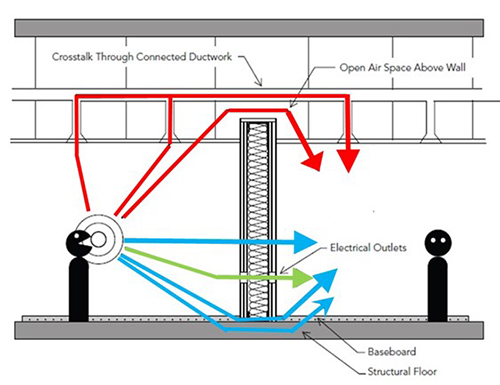 Figure 1. Sound transmission between rooms can occur due to flanking paths (red), structural paths (blue) or open gaps surrounding doors or other fixtures (green)
Figure 1. Sound transmission between rooms can occur due to flanking paths (red), structural paths (blue) or open gaps surrounding doors or other fixtures (green)
In this example of coupled noise between two rooms, flanking paths (shown in red) result from sound waves moving through open areas above suspended ceilings or at the tops of walls where an indirect but open path exists between the two rooms. Even though acoustic tile may currently exist on the suspended ceilings, these types of products are not effective at blocking noise which can still travel via flanking paths between rooms, especially at lower frequencies. Sound can also be transmitted through open HVAC ducts which is considered to be another form of flanking.
Structure-borne noise (blue arrows) is a direct result of coupled vibration resulting from sound waves striking surfaces within a room. These surfaces can consist of walls, floors, ceilings and any other structures which are shared between the two rooms. The walls or floor will vibrate in sympathy with the sound energy, and this vibration will be directly transmitted into the adjoining area(s). Even heavy concrete slab floors can couple low-frequency sound energy between rooms. Finally, direct noise paths (green arrow) can be due to openings and gaps around electrical outlets, fixtures, under or around doors or windows, poor construction, or from other existing open spaces between rooms.
The process of soundproofing this room (preventing noise from entering or leaving) will first involve considerable investigative work to determine the dominant noise path(s), and deriving cost-effective solutions which will reduce the coupled noise. This often requires both acoustic and vibration measurements as well as a complete physical inspection to determine the construction of the room(s) and potential areas of concern.
For flanking noise, it is essential that any open paths between rooms be completely blocked. In Figure 2, the white arrows represent the above-ceiling open areas that may exist between rooms which will require some form of acoustic blocking. This may involve the installation of high-mass vinyl barrier (Figure 3) or other products which will prevent sound from being transmitted through these open spaces. This process can be time-consuming, and in some cases, may require the removal of old ceilings and other structures. Should a suspended ceiling with acoustic tiles be present, then the loaded vinyl product can be placed on top of the acoustic tiles (rather than in the open flanking paths) to achieve the same blocking effect to prevent noise from crossing above the ceiling and between the adjoining rooms.
Sloppy installation of acoustic blocking materials will result in poor performance. This is one of the issues we commonly see when noise-control work has been previously done by inexperienced installers. Gaps or open spacing between barrier sheets will allow sound to “leak” through. Think of the installation as being the assembly of a large fish tank. If you don’t seal the corners or find holes in the sides, the tank will obviously not hold water very long. The same principle applies (as a rough analogy) for room soundproofing.
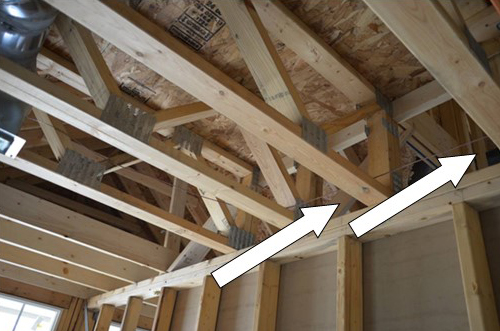 Figure 2. Open flanking paths above the ceiling are a common cause of noise being coupled between adjoining rooms. The white arrows show the open areas, which would typically be hidden from view once the ceiling has been installed. However, they will still allow for the transmission of noise.
Figure 2. Open flanking paths above the ceiling are a common cause of noise being coupled between adjoining rooms. The white arrows show the open areas, which would typically be hidden from view once the ceiling has been installed. However, they will still allow for the transmission of noise.
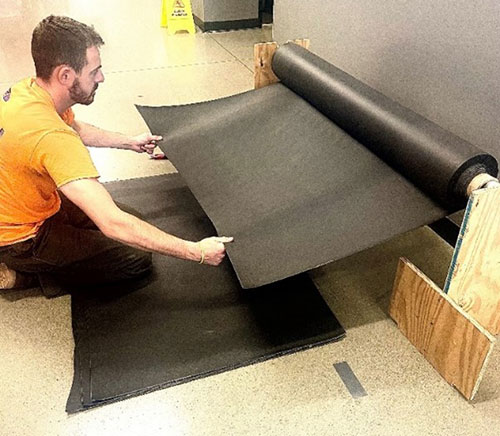
Figure 3.Cutting Vinyl Acoustic Barrier. This heavy but flexible product is carefully fitted over all areas which are susceptible to noise flanking so as to block any acoustically open paths between rooms. There are other options, but this approach is often the most economical. It is essential that the installation is done properly, with no gaps between adjoining barrier panels.
Baffles can be used within ductwork to reduce acoustic energy which can flow through the ducts to other locations. These products reduce transmitted sound energy without reducing airflow requirements for HVAC systems. A variety of designs are available and must be specified based on the size of the ducts, as well as the required airflow (CFM) of the system. See Figure 4 for an example of this concept.
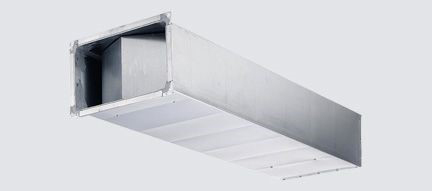 Figure 4. Duct sound attenuator. A variety of designs are available depending on the degree of sound attenuation required and desired airflow.
Figure 4. Duct sound attenuator. A variety of designs are available depending on the degree of sound attenuation required and desired airflow.
In most instances, the building’s structural design is also a contributing factor in soundproofing. Thin gypsum walls with little or no insulation between them (Figure 5) will allow considerable sound energy to be transmitted through them, and are thus likely to exhibit vibration-induced (structureborne) noise being coupled to the adjoining room. This is clearly noticeable when ‘bass’ notes or deep male voices are present, as these low frequencies can cause vibration on the wall surfaces, which is then readily coupled through the wall structure and into the adjoining room.
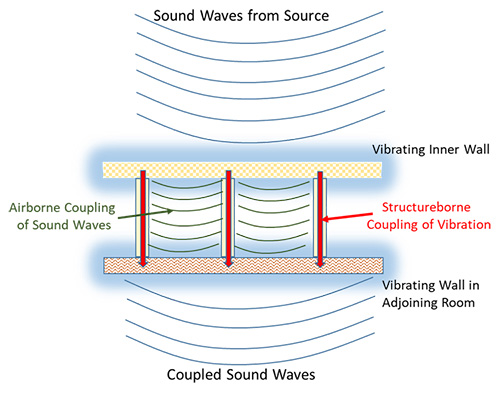 Figure 5. Typical interior wall construction. Direct structural and acoustic paths exists within the wall. Sound-induced vibration on the inner wall is directly coupled to the adjoining wall through the studs. In addition, sound waves can be directly transmitted between walls in the open space between them. This is true even if standard fiberglass is used between wall panels, as fiberglass does not block sound.
Figure 5. Typical interior wall construction. Direct structural and acoustic paths exists within the wall. Sound-induced vibration on the inner wall is directly coupled to the adjoining wall through the studs. In addition, sound waves can be directly transmitted between walls in the open space between them. This is true even if standard fiberglass is used between wall panels, as fiberglass does not block sound.
Remedying this problem is usually not a simple task. There are typically two choices: 1) one side of the wall is removed and high density vinyl barrier or thick rock wool is installed between the walls. It is also necessary to isolate the walls from the studs via the use of a damping caulk compound or other means). Or 2) an additional layer of thick gypsum board is added to the exterior of the current walls, and a layer of vibration-absorbing adhesive or other damping material is applied between the existing wall and the newly added wall, creating a constrained-layer (“sandwich”) structure. Again, the objective is to isolate any structural vibrations and to add mass to the walls such that the sound waves striking the wall have less propensity to cause the walls to vibrate in sympathy with the sound.
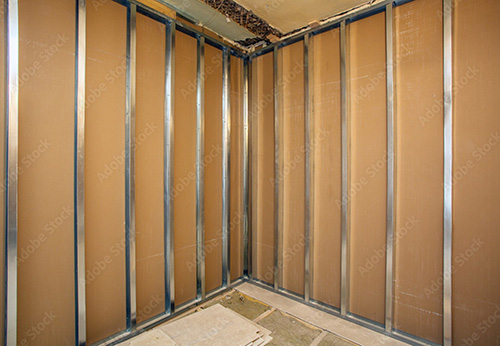 Figure 6. Typical interior wall construction (one side only shown) with steel studs and thin gypsum board being used. Low frequency noise will commonly be transmitted between the two rooms due to vibration (structureborne energy) being readily coupled between the two wall surfaces. The inclusion of thermal insulation (such as fiberglass) between the wall surfaces will not reduce the noise being coupled between rooms. The fact that the walls are directly attached to the steel frame produces a direct structural path between the adjoining walls.
Figure 6. Typical interior wall construction (one side only shown) with steel studs and thin gypsum board being used. Low frequency noise will commonly be transmitted between the two rooms due to vibration (structureborne energy) being readily coupled between the two wall surfaces. The inclusion of thermal insulation (such as fiberglass) between the wall surfaces will not reduce the noise being coupled between rooms. The fact that the walls are directly attached to the steel frame produces a direct structural path between the adjoining walls.
There are other methods which can be used to reduce structurally-coupled noise within adjoining walls, which go beyond the scope of this summary. Just be aware that, in order to reduce vibration through walls, there are only two choices; 1) break-up the structural paths, or 2) add enough mass to the walls such that acoustically induced vibration is minimized (i.e. the sound waves do not have enough energy to excite the mass). If you are adding mass, the process used to bond the material to the current walls is critical. “Gaps” or poorly bonded areas will serve no benefit. Most walls in apartments and strip malls are of very simple construction (Figure 6), and will require considerable improvements to rectify structureborne noise transmission.
Floors and building frame elements can also transmit structureborne vibration. In severe cases (such as rooms located above gyms, music venues, bars, etc.) where very loud bass is commonly produced, it can be extremely challenging to reduce structureborne noise, as the entire building may be vibrating in sympathy with high-powered subwoofers (Figure 7). In these instances, it is essential that the speakers be physically decoupled from the floors and ceilings (i.e. mounted using acoustic isolation materials), such that the physical decoupling of the speakers from walls and ceilings is maximized. Significant mass also must be added to the walls near the sound source(s) to reduce bass-induced vibrations. And even if this is done properly, given enough bass energy, vibration can still be coupled to other rooms since the building foundation is also vibrating due to the low frequency sound sources. A considerable amount of engineering and specialized structural modifications are usually required to assure success in some situations. This is why the acoustic isolation of rooms with large sound systems often becomes very expensive.
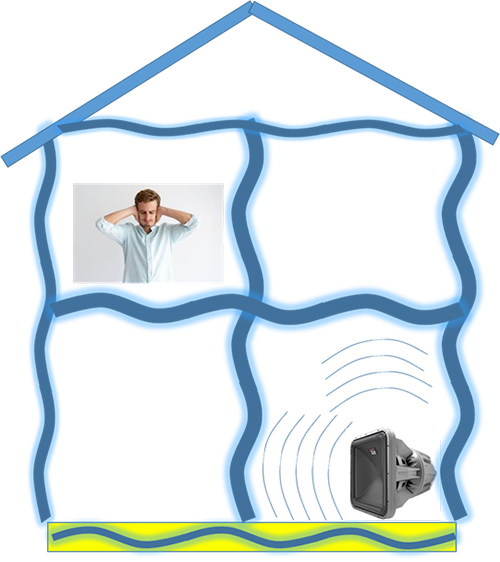 Figure 7. Vibrations transmitted throughout a building structure due to low frequency sound. Even with significant acoustical treatment of the walls, vibrations can still be present in the foundation, which can be extremely challenging to control. Isolation of the speaker and adding mass to the walls becomes essential in these situations.
Figure 7. Vibrations transmitted throughout a building structure due to low frequency sound. Even with significant acoustical treatment of the walls, vibrations can still be present in the foundation, which can be extremely challenging to control. Isolation of the speaker and adding mass to the walls becomes essential in these situations.
Lastly, the presence of openings in or around walls is always a concern when soundproofing rooms. These openings are cause for direct path (line-of-sight) noise transmission. Some of these openings are obvious, such as gaps under or around doors, near wall outlets, etc. Many gaps can easily be eliminated via the use of acoustic sealants, gaskets, and caulk. However, there are often small openings present in walls which are not obvious unless a complete physical inspection is performed. See Figure 8. In this instance, it is apparent that the builder did not do a very good job of fitting the wall panels to the frame, resulting in a large open gap on top. A good rule of thumb is that, if you can see light coming through walls or ceilings between rooms (even above the ceiling tiles), then noise can readily ‘escape’ from the source room and into the adjoining areas.
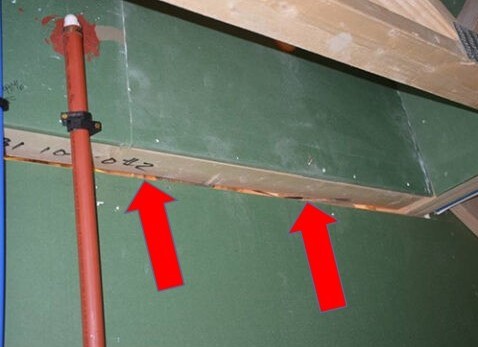
Figure 8. Example of poorly fitted wall panels, with an obvious visible gap to the adjoining room. If you can see light from the opposite side, an acoustic path is present. It is essential that these openings be sealed in order to minimize noise transmission.
MEMTECH ACOUSTICAL has extensive experience in addressing even the most challenging soundproofing concerns, and has worked with bars, work-out facilities and other venues where loud music is an issue in adjoining rooms or other areas of a building. We will perform a complete physical inspection, and if necessary, can conduct both acoustic and vibration measurements to determine noise and structure borne paths, and provide complete ‘turn-key’ solutions, including the engineered design, specification and purchase of materials, installation and validation services.
Soundproofing is particularly critical in medical facilities due to HIPPA requirements to assure that patients’ personal information remains confidential. Please refer to our section on Medical Facilities for more information.
